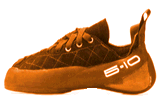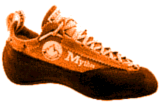
|
Women's Rock Shoes Climbing shoe co.'s try to find a fit with the women's market. We all know that men and women are from different planets, but do those logistics bear any weight when it comes to choosing a climbing shoe? Five-Ten Company, a climbing footwear manufacturer, went out on a limb late in 1995 with the first women-specific climbing shoe. Other officials from manufacturers like Boreal and La Sportiva claim they have shoes that will meet the needs of women climbers too, yet the shoes are not marketed as specific to women. Learning more about climbing footwear and how manufacturers view the foot is the way to start the decision-making.
On first look, the Diamond is an eye grabber, black quilted leather with a stealthy appearance. While some climbers donít mind the black, it can get rather toasty on warm days. But tíKint claims that the look followed a performance-driven design and the shoe is quite comfortable with an Aptec liner that has a super thin foam lining between the shoe and the liner. The shoeís design encompasses a narrow heel, a higher arch, a low-volume instep and a side-exit heel seam that allows the Achilles area some breathing room. Diamonds are asymmetrical as well. The shoe has an "S Curve" lace system that, by offering more points of adjustment and thus minimizing dead space, further allows the shoe to hug the foot. "The foot in general has a strange shape," tíKint said. "With the curved lace system, the shoe can better conform to the foot and you can feel amore customized fit. That really makes a difference when youíre cranking on a hard route," she said. But, tíKint said, there is no such thing as a climbing shoe that will do all things equally well. "Slippers are rarely comfortable on long routes, especially if any edging is involved and 'general purpose' shoes are seldom ideal for gyms because their stiff midsoles impair sensitivity. However, the Diamond is designed for as much versatility as possible. For example, Mia Axon uses them for bouldering contests, yet Steph Davis chooses them for long routes in Yosemite Valley," she said. The Diamond is built in U.S. women's sizes so it's pretty easy to find the right fit. "Most women drop one half size from their standard street shoe size. Ifyou want extra precision at the price of a little comfort, drop down a full size or size-and-one-half," she said.
Borealís technical representative, Linh Nguyen, said he applauds Five-Tenís designers of the Diamond, especially on the area of the shoearound the heel area. However, Nguyen said he feels Borealís line of climbing shoes offers a fit for every foot - menís or womenís. "The most popular shoe in our line, that women have really spoken highly of, is the Laser," he said. "Itís lower volume and extremely sensitive, with an unlined upper." The Laser, he said, has a strong "cult" following among women climbers. Boreal chose not to import the Laser in 1997, a move that Nguyen said provoked some angry response among women climbers. It will be back for 1998 with a couple of slight cosmetic changes. Retailing for $133, it offers slip-lasted construction; slip-lasted shoes are made from a completed sock of a boot, to which the midsole and the outsole are glued. It offers more sensitivity than board-lasted shoes, which are more stiff as the uppers are built into the midsole of the shoe. "In that respect, the Laserís midsole is thinner which gives greater sensitivity," Nguyen said. "We have models of shoes built on wide lasts and narrow lasts; the Laser is a shoe built on the narrower last." Nguyen said that while looking for a climbing shoe, a shop employee can be the best resource, "the retailers should see if your foot is wide or narrow and should have a wide selection of boots that fit each type of foot."
"One of the things that La Sportiva has going for it is that in almost every model of our shoes, the uppers are designed so that thereís enough room to wrap around a wide foot or close down around a narrow foot," he said. "There are at least six to eight lasts for 12 models of shoes," Oliver said. Lasts are a mold for a shoe. The Five-Ten Diamond, for example, is built on a womenís-specific last. The Mythos is also a slip-lasted shoe and retails for $137.50. Itís also unlined, a feature that Oliver said makes the shoe "break-in" and really grow to fit around menís or womenís feet. "Generally, women have a lower-volume foot — thatís only generally," Oliver said. "In rock shoes, we fit tight so the differences between menís and womenís shoes isnít so much an issue." Hiking boots, however, are another issue. Oliver said that foot bend, arch length, total length, width and volume of the foot are critical for hiking boot fit and La Sportiva has incorporated womenís lasted hikers into the line because of this. "We are very supportive of womenís specific footwear. We started looking into a womenís rock shoe about four years ago, but we looked at it and decided that we already make a shoe that women really think is great — the Mythos," Oliver said. Women climbers should be picky when it comes to choosing rock shoes. The Diamond has done us a service in that its presence draws a lot of attention to our needs as women climbers. If you have an allegiance to a non-women specific shoe, obviously stay with what works for you. But, the introduction of the Diamond, which is not a manís shoe with a girlie paint job, makes the outdoor industry take an even more serious look at our needs. All feet are different. Take your foot's advice when you go to your shop or to a demo day. — Kristen Carpenter, Mountain Zone contributor
|
||
|
Visit MountainZone.com's Marketplace, featuring over 7,000 outdoor products. We offer a vast selection of climbing gear, including books and videos. Check it out! | ||
Go back to Gear Review

